My clients know that our sessions will gear around the win-win-win. No matter what the idea, if it’s not great for all parties involved, it just won’t work.
work.
Recently a client suggested that she wanted her store to give back to the non-profit initiatives in her community but she didn’t quite know how to tackle it.
It’s no surprise that companies who include a charitable component attract a loyal customer following as well as loyal employees, so I was happy to help her plan it out.
While she is all heart and focused on the helping end, being the logical, cautious person I am, I came up with a 10 Step Approach to the planning stages. I’ll share them with you.
- Schedule a meeting with the non-profit point of contact.
- Ask questions as to how you can participate in their current initiatives and donate a portion of your sales, or another approach, while still making money as a business.
- List your constraints and what you’re willing to do and what you cannot do. In this case, my clients are in their store full time and didn’t have a spare minute to give. Whatever they did, it had to be in their store.
- What is the non-profit organization willing to do on their part to help you succeed? If success means people coming to the store to raise donations, it’s to their advantage if they spread the word about your company to their followers, thus increasing sales plus donations. They have to make the effort!
- Ask the non-profit what other companies similar to yours have participated in the past and what exactly did they do?
- Go to those companies and ask what their experiences were in working with that non-profit and what the overall results were.
- DO NOT agree to anything at the initial meeting! Listen to the suggestions, take notes, and bring it back to your team for feedback.
- Come up with what you are comfortable doing and donating.
- Check your products for the profit margin – what can you work with? You still need to make money!
- Run it by your accountant: can I afford to do this? What do I need to track for tax purposes?
My accountant would likely tell you to place #10 as #1 and I probably agree – you should run it by your accountant first, but fact finding is never a bad thing. And note that there’s a lot of fact finding going on. Never let emotions get the better of you and jump into something without a clear understanding of all the details. And of course, if you have a business partner, that person must also be involved and on board. It also helps if you discuss it with your business strategist 😊.
Approach this almost as a scientific experiment, noting and measuring everything. Furthermore, the first time you attempt anything like this, do it on a small scale. Perhaps run a special sale or initiative for one month. It helps when there is a start and end date, preferably not longer than 30 days. Check your sales goals and expectations for that period against the actual results. What are the sales for that month as compared to that month last year without the charity component?
Would you do it again? Why or why not? What would you do differently or same for next time?
Here’s an often-overlooked key: check in with the reaction of your customers – are they happy to participate? Do they care? If you continually do run these charitable programs, are they excited or are they going to feel like it’s dragging on forever? People don’t approach donating the same way. Expect to see some interesting reactions.
And lastly, while being an anonymous charity giver is wonderful on your personal time, since this is your company we’re talking about, you’ll get to the win-win-win if it’s an active part of your marketing. You want to drive people to your business because more sales results in more donations for the charity. Don’t keep it a secret – let everyone know so they can participate if they’d like.
Has your company been a part of a charitable initiative? Reach out to me and tell me how it went. What are the lessons learned? Email me to share your story.

